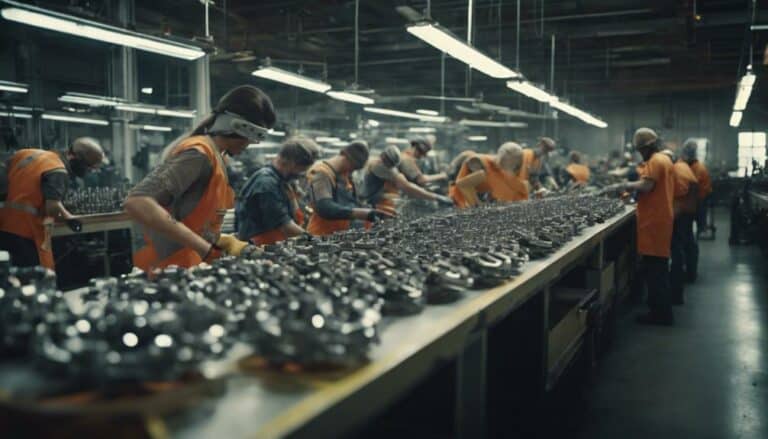When you rev up your Harley Davidson, you're not just riding a machine; you're cruising on a global highway of parts. Ever wondered where those components that make your bike roar come from?
The intricate web of origins may surprise you. Let's dissect the supply chain and explore how this mix of international sourcing impacts the iconic American brand.
Key Takeaways
- Harley sources parts from countries like the U.S., Japan, Italy, Mexico, China, and Australia to ensure quality and innovation.
- The blend of imported components and domestically made core elements highlights Harley's commitment to craftsmanship.
- Despite global partnerships, Harley assembles bikes in the USA, maintaining transparency in parts sourcing for high standards.
- Managing a complex global supply chain is crucial for Harley's operations, balancing efficiency and quality.
Global Sourcing of Harley Parts
Harley Davidson's global sourcing of parts from countries such as the U.S., Japan, Italy, Mexico, China, and Australia plays a crucial role in its production process and supply chain management. These diverse sources ensure that Harley can access high-quality components from around the world, contributing to the iconic design and performance of their motorcycles. The U.S. provides key components like frames and engines, while Japan and Italy offer expertise in precision engineering for parts such as brakes and suspension systems. Mexico and China contribute to the supply chain with cost-effective manufacturing capabilities, making Harley's bikes more accessible to a broader market. Australia's involvement brings unique elements like specialized alloys for lightweight yet durable components.
The international presence of Harley's parts sourcing not only enhances the quality and innovation of their motorcycles but also showcases the brand's commitment to global partnerships. By leveraging the strengths of different countries, Harley Davidson creates a network of suppliers that support its mission of delivering top-notch products to riders worldwide.
Supply Chain Complexity
The intricate web of global sourcing and manufacturing locations interlaces to form a complex supply chain for Harley Davidson. With manufacturing plants spread across the U.S., Thailand, India, and Brazil, the company navigates a complex international supply chain.
Parts sourced from countries like Japan, Italy, Mexico, and China, such as turn signals from Taiwan, front forks from Japan, and pistons from Germany, contribute to the intricate network of component origins. Operational challenges arise from managing this global supply chain, impacting Harley Davidson's production processes and overall global operations.
The imposition of EU tariffs on U.S. products further added to the complexity, prompting the company to shift some production overseas. Successfully managing this complex international supply chain is crucial for Harley Davidson to ensure efficient operations and meet the demands of its customers worldwide.
Foreign Manufacturers and Harley
Importantly, the global reach of Harley Davidson necessitates close partnerships with foreign manufacturers to source crucial components for their iconic motorcycles. Harley Davidson relies on foreign manufacturers from countries like Taiwan, Japan, Germany, and Mexico for various parts.
For instance, turn signals are crafted in Taiwan, front forks on specific models are sourced from Japan, and pistons are manufactured in Germany. This collaboration extends beyond these countries, with Harley importing parts from places like China and Australia as well. The company's global sourcing strategy is evident in its supply chain, where the majority of components come from international sources.
Despite this widespread network of foreign manufacturers, certain core elements such as the engine, transmission, frame, bodywork, and some electrical components are proudly made in the USA. This blend of imported and domestically produced parts underscores Harley Davidson's commitment to quality and innovation in crafting their renowned motorcycles.
Impact on American Manufacturing
As American manufacturing faces the impacts of Harley Davidson's sourcing practices from various countries, the landscape of production and supply chains undergoes significant shifts. Harley Davidson's sourcing of parts from countries like Taiwan, Japan, Italy, Germany, and Mexico has influenced American manufacturing. The closure of the Kansas City plant and the establishment of a plant in Thailand were driven by rising import costs, affecting American production. Efforts are being made to ensure that Harley Davidson motorcycles assembled for American customers contain American-made parts. Additionally, EU tariffs on U.S. products prompted Harley Davidson to shift some production overseas, further impacting the American manufacturing landscape. The company's international expansion and complex supply chain highlight the global impact on American manufacturing.
| Keywords | Impact on American Manufacturing |
|---|---|
| Parts sourcing | Influence from various countries |
| Global impact | Shifting production landscape |
| Import costs | Closure of Kansas City plant |
| American production | Efforts to include American-made parts |
Transparency in Harley Davidson Parts
Amidst the intricate network of global parts sourcing for Harley Davidson motorcycles, the aspect of transparency in the origins and composition of these essential components becomes a critical focal point. Harley Davidson's commitment to quality and cost-efficiency drives its reliance on international suppliers for parts like turn signals from Taiwan, front forks from Japan, and pistons from Germany. This diverse sourcing strategy extends to countries like Italy and Mexico, showcasing a global approach to meeting the demands of the American market.
To ensure optimal performance, Harley Davidson maintains long-standing relationships with key suppliers such as Showa and Mikuni for critical components like forks, shocks, and carbs. Despite this international sourcing, Harley Davidson upholds its tradition of assembling bikes in the US, balancing the need for quality control and cost considerations. By embracing transparency in their parts sourcing, Harley Davidson demonstrates a commitment to delivering motorcycles that meet the highest standards of craftsmanship and performance.
Conclusion
You may be surprised to learn the diverse origins of Harley Davidson parts, with sources spanning the globe.
The intricate supply chain and reliance on foreign manufacturers have both benefits and challenges for the iconic American brand.
As the company navigates this complex landscape, transparency in the sourcing of parts becomes increasingly important.
Stay tuned for more updates on how Harley Davidson continues to balance tradition with globalization in the ever-evolving world of motorcycle manufacturing.

